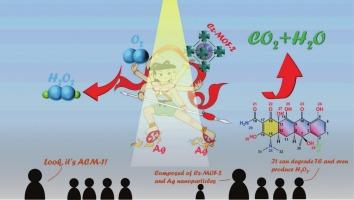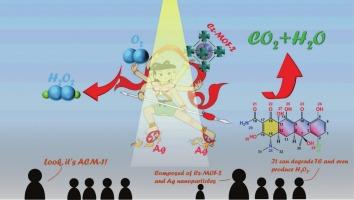纳米银辅助下咔唑基金属有机骨架光催化抗生素降解及H2O2绿色生成
IF 6.5
1区 化学
Q2 CHEMISTRY, PHYSICAL
引用次数: 0
摘要
四环素是一种广泛使用的抗生素,在环境中持续存在,是一种重要的污染物,其有效降解对生态系统和人类健康至关重要。同时,过氧化氢作为一种重要的化工原料和绿色氧化剂,其绿色生产在各个领域都具有重要意义。在本研究中,通过对Cz-MOF-2进行合成后修饰,成功合成了一种新型可见光响应光催化剂ACM-X系列材料,并在表面沉积了Ag纳米颗粒,显著提高了其光催化性能,在模拟太阳光照下可高效降解四环素(TC)并高产出过氧化氢(H2O2)。通过x射线衍射(XRD)、扫描电子显微镜(SEM)、透射电子显微镜(TEM)、x射线光电子能谱(XPS)和电化学测量证实,银表面等离子体共振(SPR)效应对提高电荷分离效率起着至关重要的作用。ACM-1催化剂表现出优异的光催化活性,在60 min内实现95% %以上的TC降解,H2O2产率为50 μmol/h。自由基清除实验和电子顺磁共振(EPR)技术证实,超氧阴离子自由基(·O2−)、羟基自由基(·OH)和单线态氧(1O2)等活性氧(ROS)是光催化过程中的关键中间体。密度泛函理论(DFT)计算表明,Ag修饰减小了Cz-MOF-2的带隙,增强了光吸收,促进了电子转移。发现在银作为电子和质子转移介质的作用下,生成H2O2的2e -氧还原反应(ORR)是自发的。此外,用质谱仪分析了四环素(TC)的降解途径。ACM−1催化剂在多次循环使用中表现出优异的稳定性和可重复使用性,突出了其在环境修复和可持续化学合成方面的潜力。这项工作为设计用于太阳能转换和污染物降解的先进光催化剂提供了一种有前途的策略。本文章由计算机程序翻译,如有差异,请以英文原文为准。


Carbazolyl-based metal organic framework for photocatalytic antibiotic degradation and H2O2 green generation assisted by silver nanoparticles
Tetracycline, a widely used antibiotic that persists in the environment, is a significant pollutant, making its efficient degradation crucial for ecosystem and human health. Meanwhile, green production of hydrogen peroxide, an important chemical raw material and green oxidant, is significant in various fields. In this study, a novel visible-light-responsive photocatalyst, the ACM-X series material, was successfully synthesized through post-synthetic modification of Cz-MOF-2, with the deposition of Ag nanoparticles on the surface significantly enhancing the photocatalytic performance, enabling efficient degradation of tetracycline (TC) and high-yield production of hydrogen peroxide (H2O2) under simulated solar light irradiation. The Ag surface plasmon resonance (SPR) effect played a crucial role in improving charge separation efficiency, as confirmed by X-ray diffraction (XRD), scanning electron microscopy (SEM), transmission electron microscopy (TEM), X-ray photoelectron spectroscopy (XPS), and electrochemical measurements. The ACM-1 catalyst demonstrated exceptional photocatalytic activity, achieving over 95 % TC degradation within 60 min and a H2O2 production rate of 50 μmol/h. The free radical scavenging experiments and electron paramagnetic resonance (EPR) technique confirmed that reactive oxygen species (ROS), including superoxide anion radicals (·O2−), hydroxyl radicals (·OH) and singlet oxygen (1O2), were identified as key intermediates in the photocatalytic process. Density functional theory (DFT) calculations revealed that Ag modification reduced the band gap of Cz-MOF-2, enhancing light absorption and promoting electron transfer. The 2e− oxygen reduction reaction (ORR) for H2O2 production was found to be spontaneous, with Ag acting as an electron and proton transfer mediator. Additionally, the degradation pathway of tetracycline (TC) was elucidated by using a mass spectrometer. The ACM − 1 catalyst exhibited excellent stability and reusability during multiple cycles of use, highlighting its potential in environmental remediation and sustainable chemical synthesis. This work provides a promising strategy for the design of advanced photocatalysts for solar energy conversion and pollutant degradation.
求助全文
通过发布文献求助,成功后即可免费获取论文全文。
去求助
来源期刊

Journal of Catalysis
工程技术-工程:化工
CiteScore
12.30
自引率
5.50%
发文量
447
审稿时长
31 days
期刊介绍:
The Journal of Catalysis publishes scholarly articles on both heterogeneous and homogeneous catalysis, covering a wide range of chemical transformations. These include various types of catalysis, such as those mediated by photons, plasmons, and electrons. The focus of the studies is to understand the relationship between catalytic function and the underlying chemical properties of surfaces and metal complexes.
The articles in the journal offer innovative concepts and explore the synthesis and kinetics of inorganic solids and homogeneous complexes. Furthermore, they discuss spectroscopic techniques for characterizing catalysts, investigate the interaction of probes and reacting species with catalysts, and employ theoretical methods.
The research presented in the journal should have direct relevance to the field of catalytic processes, addressing either fundamental aspects or applications of catalysis.
 求助内容:
求助内容: 应助结果提醒方式:
应助结果提醒方式:


